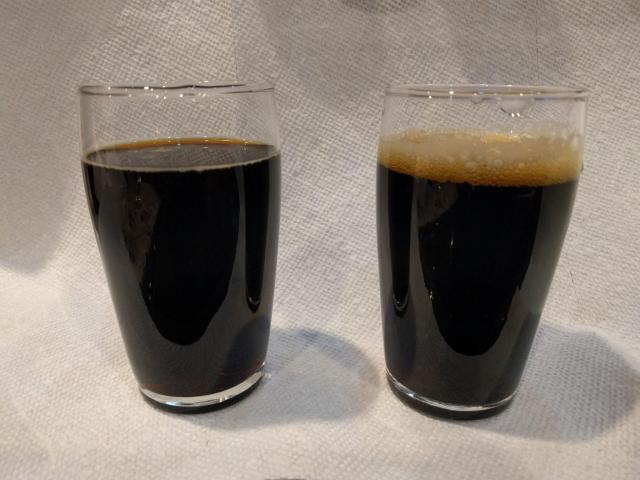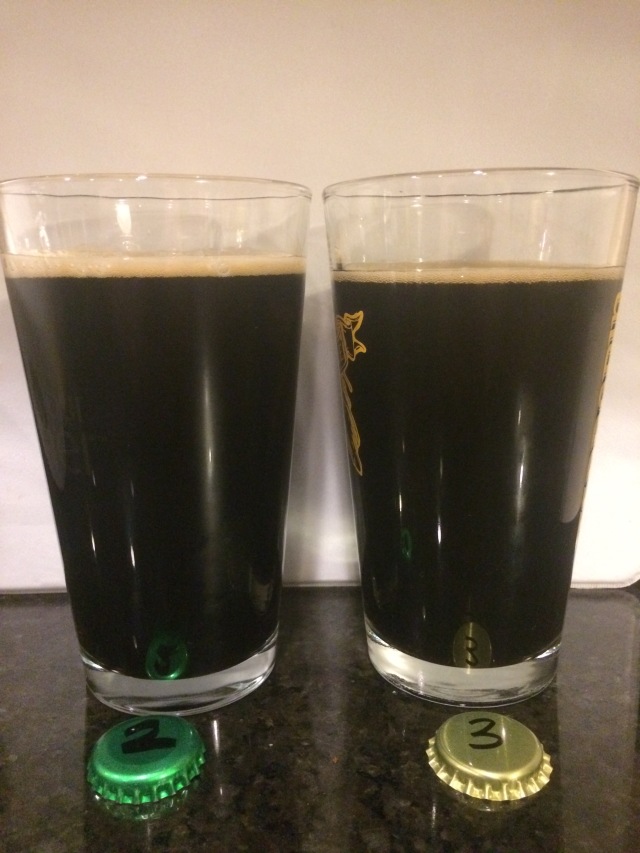This post is one in a series following six brewers collaborating to each make a small adjustment to a single recipe in order to improve it, then pass it along to the next brewer. We hope to learn more about the art of recipe creation as we see how other brewers approach the same recipe. The rest of the comparison tastings for this series can be found here.
The recipes for the beers being compared below are as follows:
| Iteration 2 | Iteration 3 | |
| Base Malt | 80% 2-row | 80% 2-row |
| Specialty Malt 1 | 10% Victory | 5% Victory |
| Specialty Malt 2 | 5% Roasted Barley | 10% Roasted Barley |
| Specialty Malt 3 | 5% Chocolate Malt | 5 % Chocolate Malt |
| 60 min. hop | Nugget: 42.5 IBUs | Nugget: 47.7 IBUs |
| 5 min. hop | Willamette: 3.3 IBUs | Willamette: 2.9 IBUs |
| Yeast | US-05 | US-05 |
| OG | 1.060 | 1.045 |
| FG | 1.016 | 1.005 |
| ABV | 5.8% | 5.25% |
Taster: B. Crochet
Iteration 2, when poured, had very little carbonation. The head was barely there and dissipated quickly. Iteration 3 had a more robust head, with some good lacing on the glass as it receded to a small, but present, head. Iteration 2’s head color was tan, while Iteration 3 had more of a dark brown color, definitely attributable to the larger ratio of roasted barley. Both poured a very dark brown in color.

Left: Iteration 2; Right: Iteration 3
Iteration 2 had definite chocolate notes in the aroma. Iteration 3 had more “roasty” notes to it, along with some faint dark cherry notes, with the chocolate taking a bit of a back seat.
Iteration 2, especially as it warmed, had a sweeter character to it, almost like a sweetened cold coffee. Iteration 3 reminded me of a toasted marshmallow, but without the sweetness.
The biggest differences to me were color of the head, and the more roasted tones. Iteration 3 seemed to fall more on the roasted side, which I would attribute to the additional roasted barley. I’m not sure I would say that there was a definite improvement, but I feel like some improvement was made. That could also be chalked up to personal taste. I don’t think anything was lost from the previous iteration that made a strong impact on the overall quality of the recipe.
Taster: C. McKenzie
Iteration 2 was black and poured with a moderate white head that had moderate retention. Iteration 3 was also black, but had a moderate tan head that diminished rapidly.

Iteration 2’s aroma was one of cold-brewed coffee and dark chocolate. Iteration 3 had a prominent roasted scent in the nose, as well as coffee and chocolate notes.
Iteration 2 tasted of coffee with a nice roasted note and some toasty flavors. Iteration 3 tasted strongly of roasted coffee—perhaps coffee that has been on the burner for several hours. I also noticed some type of red berry note coming through in the background, but I am admittedly not certain on the accuracy of that description.
